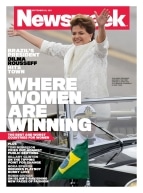Newsweek Magazine’s Global Women’s Progress Report: Where Women Are Winning
September 20, 2011
 By Jesse Ellison for Newsweek – Just over a decade into the 21st century, women’s progress can be seen—and celebrated—across a range of fields. They hold the highest political offices from Thailand to Brazil, Costa Rica to Australia. A woman holds the top spot at the International Monetary Fund; another won the Nobel Prize in economics. Self-made billionaires in Beijing, tech innovators in Silicon Valley, pioneering justices in Ghana—in these and countless other areas, women are leaving their mark.
By Jesse Ellison for Newsweek – Just over a decade into the 21st century, women’s progress can be seen—and celebrated—across a range of fields. They hold the highest political offices from Thailand to Brazil, Costa Rica to Australia. A woman holds the top spot at the International Monetary Fund; another won the Nobel Prize in economics. Self-made billionaires in Beijing, tech innovators in Silicon Valley, pioneering justices in Ghana—in these and countless other areas, women are leaving their mark.
But hold the applause. In Saudi Arabia, women aren’t allowed to drive. In Pakistan, a thousand women die in honor killings every year. And in Somalia, 95 percent of women are subjected to genital mutilation. In the developed world, women lag behind men in pay and political power. The poverty rate among women in the U.S. rose to 14.5 percent last year, the highest in 17 years.
To measure the state of women’s progress, Newsweek ranked 165 countries, looking at five areas that affect women’s lives: treatment under the law, workforce participation, political power, and access to education and health care. Poring over data from the United Nations and the World Economic Forum, among others, and consulting with experts and academics, we measured 28 factors to come up with our rankings.
Countries with the highest scores tend to be clustered in the West, where gender discrimination is against the law, and equal rights are constitutionally enshrined. But there were some surprises. Some otherwise high-ranking countries had relatively low scores for political representation and workplace clout. Canada ranked third overall but 26th in power, behind countries such as Cuba and Burundi. Does this suggest that a woman in a nation’s top office translates to better lives for women in general? Not exactly. “Trying to quantify or measure the impact of women in politics is hard because in very few countries have there been enough women in politics to make a difference,” says Anne-Marie Goetz, peace and security adviser for U.N. Women.
Of course, no index can account for everything. Declaring that one country is better than another in the way that it treats more than half its citizens means relying on broad strokes and generalities. (The experience of a domestic servant can hardly be compared with that of an executive with an M.B.A., even if their citizenship is the same.) Some things simply can’t be measured. (Is child care better or worse when provided by grandparents, or subsidized and mandated by government?) And cross-cultural comparisons can’t account for differences of opinion. (Who’s more oppressed: the girl in the miniskirt or the one in the hijab?)
Certain conclusions are nonetheless clear. For one thing, our index backs up a simple but profound statement made by Secretary of State Hillary Clinton last week at the Asia-Pacific Economic Cooperation summit, as she declared a tipping point for women. “When we liberate the economic potential of women, we elevate the economic performance of communities, nations, and the world,” she said. “There is a stimulative and ripple effect that kicks in when women have greater access to jobs and the economic lives of our countries: Greater political stability. Fewer military conflicts. More food. More educational opportunity for children. By harnessing the economic potential of all women, we boost opportunity for all people.”
Indeed, the 20 countries that are best for women almost all have democratically elected governments and GDPs above $200 billion. Economies flourish when women are included, in no small part because women reinvest some 90 percent of their income into communities and family, compared with the less than 40 percent reinvested by men. The countries that ranked last are poor, in some cases ripped apart by war, and largely dependent on aid from the West. Afghanistan has one of the highest maternal mortality rates in the world. In Chad, where per capita income is just $164 a year and women need their husband’s permission to open bank accounts, just 20 percent of adult women can read. No wonder, then, that global nonprofits are turning their attention to women and girls. At this week’s Clinton Global Initiative, more than 50 new programs will be announced, including curbing sexual violence in Haiti and efforts to end child marriage. (To see the event live, go to thedailybeast.com.)
In our own research, the country that holds some of the most significant lessons doesn’t rank at the top or the bottom, although a decade ago, it almost surely would have come close to last. In 2003, after decades of civil war, Rwanda’s transitional government passed legislation requiring that a third of the seats in Parliament be held by women. Today, its Parliament is more than 50 percent women, and girls are enrolled in secondary school at the same rate as boys. Last year the World Economic Forum ranked Rwanda first among East African nations in economic innovation.
There are lessons here for the Middle East as it emerges from the Arab Spring. With some states all but starting from scratch, tackling gender inequality may rank low on the list of priorities. But it shouldn’t. “The vibrancy of these potential democracies will depend on the participation of women,” says Melanne Verveer, ambassador at large for global women’s issues at the U.S. State Department. Or in Goetz’s words, “Excluding women from post conflict recovery would be like trying to tie your shoes with one hand.”
Click here to read more.

